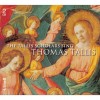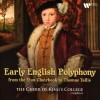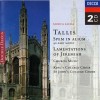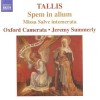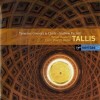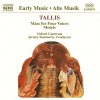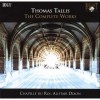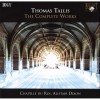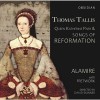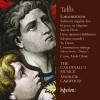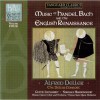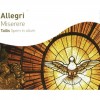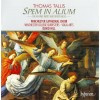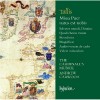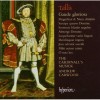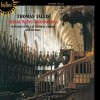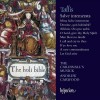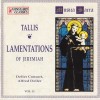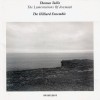Composers
Thomas Tallis (c. 1505 – 23 November 1585) was an English composer. Tallis flourished as a church musician in 16th century England. He occupies a primary place in anthologies of English church music, and is considered among the best of England's early composers. He is honoured for his original voice in English musicianship.
Contents |
Early life
Little is known about Tallis's early life, but there seems to be agreement that he was born in the early 16th century, toward the close of the reign of Henry VII. His first known appointment to a musical position was as organist of Dover Priory in 1530-31, a Benedictine priory at Dover (now Dover College) in 1532. His career took him to London, then (probably in the autumn of 1538) to the Augustinian abbey of Holy Cross at Waltham until the abbey was dissolved in 1540; then he went to Canterbury Cathedral, and finally to Court as Gentleman of the Chapel Royal in 1543, composing and performing for Henry VIII during which he wrote music for the Church of England (Holman 201), Edward VI (1547-1553), Queen Mary (1553-1558), and Queen Elizabeth I (1558 until he died in 1585) (Thomas 136). Throughout his service to successive monarchs as organist and composer, Tallis avoided the religious controversies that raged around him, though, like William Byrd, he stayed an "unreformed Roman Catholic."
Tallis married around 1552; his wife, Joan, outlived him by four years. They apparently had no children. Late in his life he lived in Greenwich, likely close to the royal palace: a local tradition holds that he lived on Stockwell Street.
Works
List of compositions by Thomas Tallis
Early works
The earliest surviving works by Tallis, Salve intemerata virgo, Ave rosa sine spinis and Ave Dei patris filia are devotional antiphons to the Virgin Mary, which were used outside the liturgy and were cultivated in England until the fall of Cardinal Wolsey. Henry VIII's break with Roman Catholicism in 1534 and the rise of Thomas Cranmer noticeably influenced the style of music written. Texts became largely confined to the liturgy. The writing of Tallis and his contemporaries became less florid. Tallis's Mass for four voices is marked with tendencies toward a syllabic and chordal style and a diminished use of melisma. Tallis provides a rhythmic variety and differentiation of moods depending on the meaning of his texts (Manderson 86). Tallis helped found a relationship that was specific to the combining of words and music (Phillips 11).
The reformed Anglican liturgy was inaugurated during the short reign of Edward VI (1547-1553), and Tallis was one of the first church musicians to write anthems set to English words, although Latin continued to be used. The Catholic Mary Tudor set about undoing the religious reforms of the preceding decades. Following the accession of the Catholic Mary in 1553, the Roman Rite was restored and compositional style reverted to the elaborate writing prevalent early in the century. Two of Tallis's major works, Gaude gloriosa Dei Mater and the Christmas Mass Puer natus est nobis are believed to be from this period. Only Puer natus est nobis can be accurately dated in 1554. As was the prevailing practice, these pieces were intended to exalt the image of the Queen as well as to praise the Mother of God.
Elizabeth succeeded her half-sister in 1558, and the Act of Settlement in the following year abolished the Roman Liturgy and firmly established the Book of Common Prayer. Composers at court resumed writing English anthems, although the practice of setting Latin texts continued, growing more peripheral over time.
The mood of the country in the beginning of Elizabeth's reign leant toward the puritan, which discouraged the liturgical polyphony. Tallis wrote nine psalm chant tunes for four voices for Archbishop Parker's Psalter, published in 1567. One of the nine tunes, the "Third Mode Melody", inspired the composition of Fantasia on a Theme of Thomas Tallis by Ralph Vaughan Williams in 1910 (Steinberg 291). Tallis's better-known works from the Elizabethan years include his settings of the Lamentations (of Jeremiah the Prophet) (Thomas 136) for the Holy Week services and the unique motet Spem in alium written for eight five-voice choirs (Barber 34). It is thought that this 40-voice piece was part of a celebration of the Queen's 40th birthday in 1573. Tallis is mostly remembered for his role in composing office hymns and this motet, Spem in alium (Cohn-Sherbok 285).
Later works
Toward the end of his life, Tallis resisted the musical development seen in his younger contemporaries such as William Byrd, who embraced compositional complexity and adopted texts built by combining disparate biblical extracts (Lord 69). Tallis' experiments during this time period were considered rather unusual (Phillips 11). Tallis was content to draw his texts from the Liturgy (Farrell 125) and wrote for the worship services in the Chapel Royal (Farrell 125). In 1543, he probably began to serve full time as a member of the Chapel Royal. The Chapel Royal later became a Protestant establishment (Farrell 125). Tallis has been variously claimed to be a Protestant, Catholic, and a religious Pragmatist. Mary granted him a lease on a manor in Kent that provided a comfortable annual income (Holman 24). Elizabeth granted to Tallis and Byrd a twenty-one year monopoly in 1575 for polyphonic music (Holman 1) and a patent to print and publish music, which was one of the first arrangements of that type in the country (Thomas 137). Tallis' monopoly covered 'set songe or songes in parts, and he was able to compose in English, Latin, French, Italian, or other tongues as long as they served for music in the Church or chamber (Holman 1). Tallis had exclusive rights to print any music, in any language (Barber 25). He and William Byrd were the only ones allowed to use the paper that was used in printing music ( Barber 25). Tallis and Byrd used their monopoly to produce Cantiones quae ab argumento sacrae vocantur but the piece did not sell well and they appealed to Queen Elizabeth for her support (Holman 1). Tallis and Byrd could work for two opposing religions as long as they did not bring their beliefs into their jobs (Lord 135). He retained respect during a succession of opposing religious movements and deflected the violence that claimed Catholics and Protestants alike (Gatens 181). Tallis endured a difficult period during the time of the church and his music often displays characteristics of the turmoil (Gatens 181).
Thomas Tallis died peacefully in his house in Greenwich in November 1585 on either the 20th or 23rd. He was buried in the chancel of the parish of St Alfege's Church. A couplet from his epitaph reads:
As he did live, so also did he die, In mild and quiet Sort (O! happy Man).
Byrd wrote the musical elegy Ye Sacred Muses on Tallis's death.
Recently Added
Biography
Thomas Tallis (c. 1505 – 23 November 1585) was an English composer. Tallis flourished as a church musician in 16th century England. He occupies a primary place in anthologies of English church music, and is considered among the best of England's early composers. He is honoured for his original voice in English musicianship.
Contents |
Early life
Little is known about Tallis's early life, but there seems to be agreement that he was born in the early 16th century, toward the close of the reign of Henry VII. His first known appointment to a musical position was as organist of Dover Priory in 1530-31, a Benedictine priory at Dover (now Dover College) in 1532. His career took him to London, then (probably in the autumn of 1538) to the Augustinian abbey of Holy Cross at Waltham until the abbey was dissolved in 1540; then he went to Canterbury Cathedral, and finally to Court as Gentleman of the Chapel Royal in 1543, composing and performing for Henry VIII during which he wrote music for the Church of England (Holman 201), Edward VI (1547-1553), Queen Mary (1553-1558), and Queen Elizabeth I (1558 until he died in 1585) (Thomas 136). Throughout his service to successive monarchs as organist and composer, Tallis avoided the religious controversies that raged around him, though, like William Byrd, he stayed an "unreformed Roman Catholic."
Tallis married around 1552; his wife, Joan, outlived him by four years. They apparently had no children. Late in his life he lived in Greenwich, likely close to the royal palace: a local tradition holds that he lived on Stockwell Street.
Works
List of compositions by Thomas Tallis
Early works
The earliest surviving works by Tallis, Salve intemerata virgo, Ave rosa sine spinis and Ave Dei patris filia are devotional antiphons to the Virgin Mary, which were used outside the liturgy and were cultivated in England until the fall of Cardinal Wolsey. Henry VIII's break with Roman Catholicism in 1534 and the rise of Thomas Cranmer noticeably influenced the style of music written. Texts became largely confined to the liturgy. The writing of Tallis and his contemporaries became less florid. Tallis's Mass for four voices is marked with tendencies toward a syllabic and chordal style and a diminished use of melisma. Tallis provides a rhythmic variety and differentiation of moods depending on the meaning of his texts (Manderson 86). Tallis helped found a relationship that was specific to the combining of words and music (Phillips 11).
The reformed Anglican liturgy was inaugurated during the short reign of Edward VI (1547-1553), and Tallis was one of the first church musicians to write anthems set to English words, although Latin continued to be used. The Catholic Mary Tudor set about undoing the religious reforms of the preceding decades. Following the accession of the Catholic Mary in 1553, the Roman Rite was restored and compositional style reverted to the elaborate writing prevalent early in the century. Two of Tallis's major works, Gaude gloriosa Dei Mater and the Christmas Mass Puer natus est nobis are believed to be from this period. Only Puer natus est nobis can be accurately dated in 1554. As was the prevailing practice, these pieces were intended to exalt the image of the Queen as well as to praise the Mother of God.
Elizabeth succeeded her half-sister in 1558, and the Act of Settlement in the following year abolished the Roman Liturgy and firmly established the Book of Common Prayer. Composers at court resumed writing English anthems, although the practice of setting Latin texts continued, growing more peripheral over time.
The mood of the country in the beginning of Elizabeth's reign leant toward the puritan, which discouraged the liturgical polyphony. Tallis wrote nine psalm chant tunes for four voices for Archbishop Parker's Psalter, published in 1567. One of the nine tunes, the "Third Mode Melody", inspired the composition of Fantasia on a Theme of Thomas Tallis by Ralph Vaughan Williams in 1910 (Steinberg 291). Tallis's better-known works from the Elizabethan years include his settings of the Lamentations (of Jeremiah the Prophet) (Thomas 136) for the Holy Week services and the unique motet Spem in alium written for eight five-voice choirs (Barber 34). It is thought that this 40-voice piece was part of a celebration of the Queen's 40th birthday in 1573. Tallis is mostly remembered for his role in composing office hymns and this motet, Spem in alium (Cohn-Sherbok 285).
Later works
Toward the end of his life, Tallis resisted the musical development seen in his younger contemporaries such as William Byrd, who embraced compositional complexity and adopted texts built by combining disparate biblical extracts (Lord 69). Tallis' experiments during this time period were considered rather unusual (Phillips 11). Tallis was content to draw his texts from the Liturgy (Farrell 125) and wrote for the worship services in the Chapel Royal (Farrell 125). In 1543, he probably began to serve full time as a member of the Chapel Royal. The Chapel Royal later became a Protestant establishment (Farrell 125). Tallis has been variously claimed to be a Protestant, Catholic, and a religious Pragmatist. Mary granted him a lease on a manor in Kent that provided a comfortable annual income (Holman 24). Elizabeth granted to Tallis and Byrd a twenty-one year monopoly in 1575 for polyphonic music (Holman 1) and a patent to print and publish music, which was one of the first arrangements of that type in the country (Thomas 137). Tallis' monopoly covered 'set songe or songes in parts, and he was able to compose in English, Latin, French, Italian, or other tongues as long as they served for music in the Church or chamber (Holman 1). Tallis had exclusive rights to print any music, in any language (Barber 25). He and William Byrd were the only ones allowed to use the paper that was used in printing music ( Barber 25). Tallis and Byrd used their monopoly to produce Cantiones quae ab argumento sacrae vocantur but the piece did not sell well and they appealed to Queen Elizabeth for her support (Holman 1). Tallis and Byrd could work for two opposing religions as long as they did not bring their beliefs into their jobs (Lord 135). He retained respect during a succession of opposing religious movements and deflected the violence that claimed Catholics and Protestants alike (Gatens 181). Tallis endured a difficult period during the time of the church and his music often displays characteristics of the turmoil (Gatens 181).
Thomas Tallis died peacefully in his house in Greenwich in November 1585 on either the 20th or 23rd. He was buried in the chancel of the parish of St Alfege's Church. A couplet from his epitaph reads:
As he did live, so also did he die, In mild and quiet Sort (O! happy Man).
Byrd wrote the musical elegy Ye Sacred Muses on Tallis's death.


